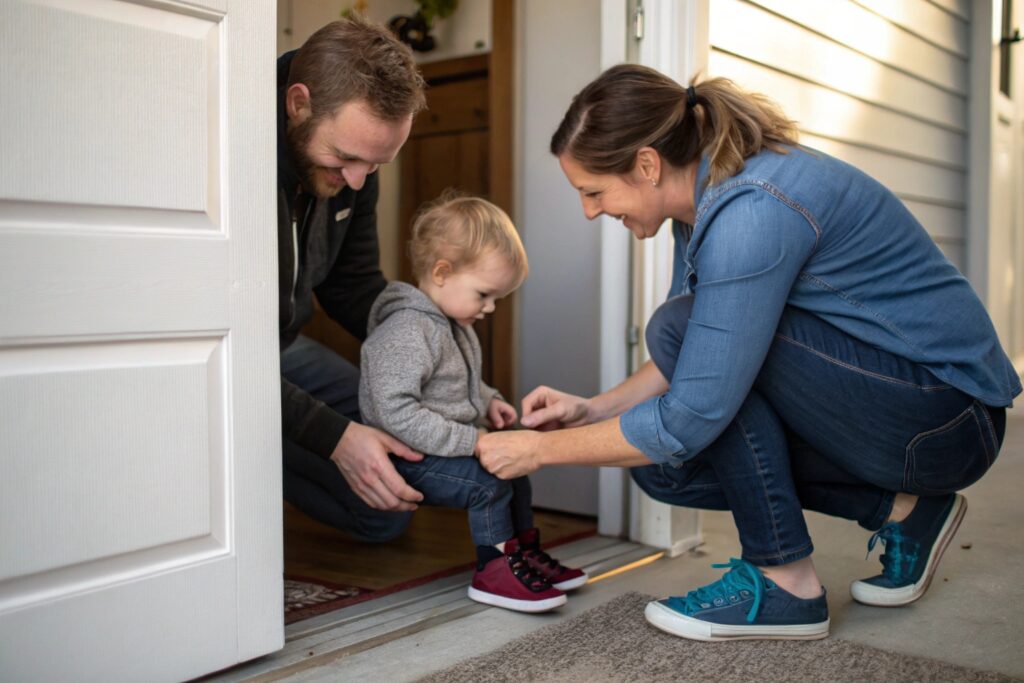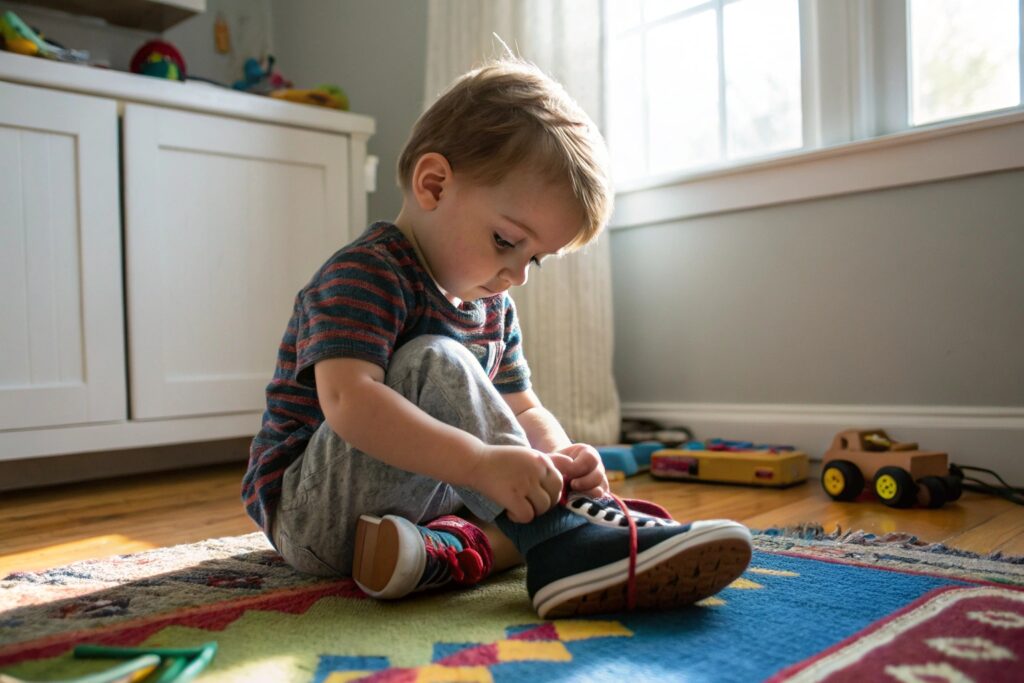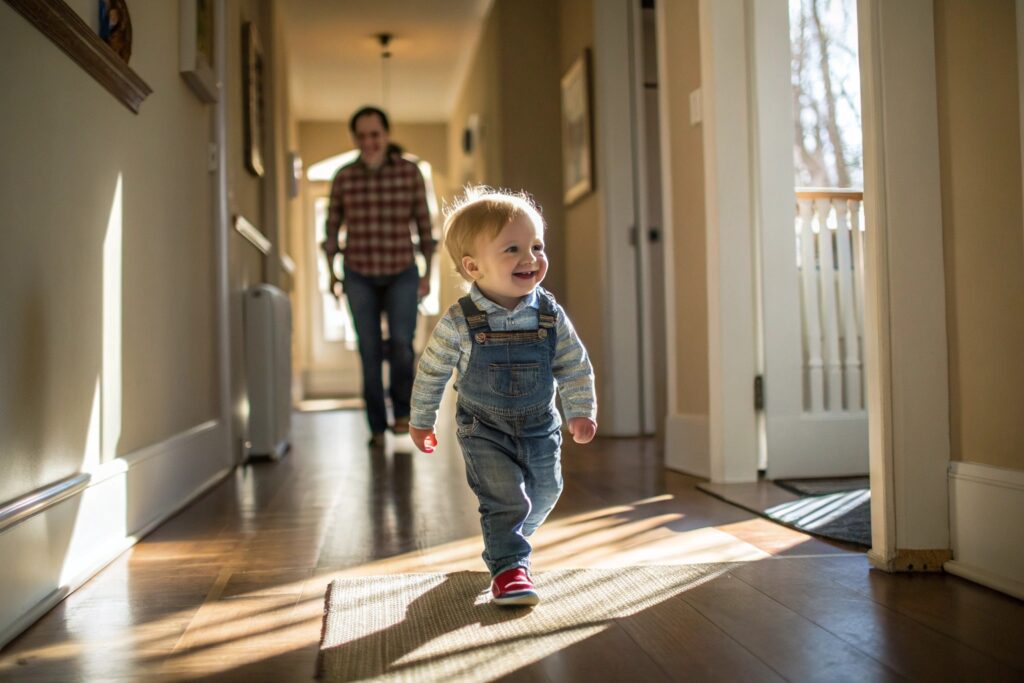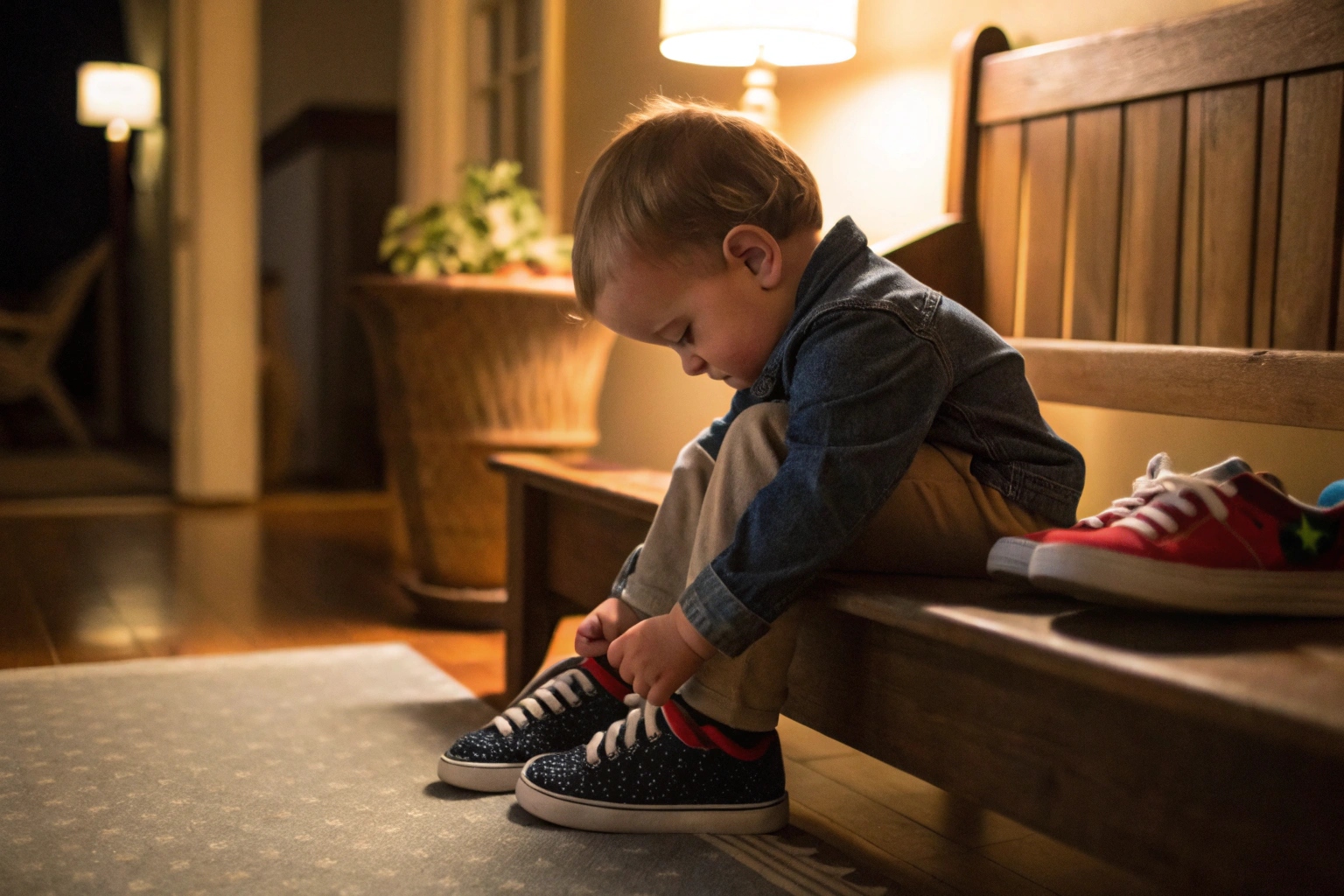You dress your child, look down, and there it is again—left shoe on the right foot, and vice versa. It happens more often than you’d think.
Children often wear shoes on the wrong feet due to undeveloped spatial awareness, motor skills, or confusion about left and right—usually a harmless phase in early development.
If this shoe switch frustrates you or makes you worry, this guide will help you understand what it means and how to gently fix it.
Is It Normal for Kids to Misplace Their Shoes?
You’re not alone. Many parents find themselves correcting their child’s shoes almost daily during the toddler and preschool years.
Yes, it’s completely normal for young kids to put their shoes on the wrong feet. It’s a common developmental stage and usually resolves naturally over time.

Why do toddlers and preschoolers struggle with shoe placement?
Children between ages 2 and 5 are still developing body awareness, visual-spatial skills, and fine motor control. These systems help them understand how objects align with their bodies and the environment. Left and right are abstract concepts—they don’t come naturally.
When a child sees two identical shoes, they may not recognize subtle differences in shape. Their goal is independence, not perfection. So if both shoes are on—mission accomplished. They often don’t notice discomfort unless it’s extreme.
Also, some shoes look almost symmetrical, especially toddler footwear with rounded toes and wide bases. That makes it harder for little ones to tell the difference visually.
What age do most kids consistently get it right?
Most children start putting their shoes on correctly without help around age 5 or 6, though many still need reminders. Before that, shoe placement mistakes are simply part of the learning curve.
Developmental stages:
| Age | Shoe Placement Skill |
|---|---|
| 2–3 yrs | Tries to put shoes on, often incorrectly |
| 3–4 yrs | Recognizes shoes have sides, still mixes them up |
| 5–6 yrs | Begins consistently placing correctly |
| 6+ yrs | Understands left/right and adjusts placement |
What Shoe Mistakes Say About Child Development
Some parents worry misplacing shoes means something’s wrong. But in most cases, it simply reflects a brain still learning direction, control, and sequence.
Shoe mistakes signal a child is practicing independence and body coordination—not developmental delay unless other signs are present.

How does incorrect shoe placement relate to cognitive growth?
Wearing shoes on the wrong feet involves several developing abilities:
- Spatial awareness – Understanding where body parts go in space
- Visual discrimination – Noticing shape and direction differences
- Sequencing – Remembering steps like sock first, then shoe
- Motor skills – Coordinating hands to fit the shoe on properly
When a child consistently makes this mistake, it often means they’re at a learning threshold. They’re attempting independence, even if the outcome isn’t correct. That’s a positive sign—they’re trying.
Cognitive processes involved:
| Skill | Role in Shoe Placement |
|---|---|
| Left/Right distinction | Knowing each shoe has a specific side |
| Body awareness | Feeling discomfort and adjusting fit |
| Visual comparison | Matching shoe shape to correct foot |
| Routine memory | Remembering how shoes fit from experience |
Are there any red flags to watch for?
While shoe errors are normal, seek guidance if your child:
- Can’t recognize foot discomfort by age 6
- Struggles with multiple body awareness tasks (like dressing or using utensils)
- Shows no progress over months of practice
- Avoids shoes entirely due to frustration
In these rare cases, an occupational therapist can assess for sensory or developmental delays. But most kids improve just by practicing daily routines.
How to Teach Kids Left From Right Easily
Saying “that’s your left shoe” rarely helps a 3-year-old. They need clear, consistent, and visual methods to learn left from right.
You can teach left/right and proper shoe placement using visual cues, fun techniques, and regular practice during dressing routines.

What techniques help kids put shoes on correctly?
Try these parent-tested methods:
1. Sticker Match:
Cut a large sticker in half and place one half inside each shoe. When shoes are placed correctly side by side, the image matches—helping the child see the proper direction.
2. Marker Arrows:
Draw a small arrow inside each shoe pointing outward. Tell them the arrows should “point to the walls” when shoes are side by side.
3. Character Faces:
Use shoes with distinguishable designs (like dinosaurs or animals). Teach the child that the animals should “face each other” when ready to wear.
4. Shoe Parking Spot:
Mark “L” and “R” on a mat or box. Ask the child to “park” each shoe in its matching spot before putting them on.
These techniques turn learning into a game, which boosts memory and excitement.
How often should you correct or remind them?
Be consistent, but not harsh. If you correct every time with frustration, they’ll associate shame with dressing. Instead, let them try on their own, then gently help if needed.
- Offer praise for effort, not just success.
- Model the behavior by showing how you place your own shoes.
- Use mirrors—kids love seeing how things look and fit.
Helpful comparison:
| Method | Benefit |
|---|---|
| Sticker halves | Visual and playful, great for young kids |
| Arrows | Easy DIY, builds direction sense |
| Character shoes | Built-in cues with fun appeal |
| L/R mat | Builds habits and foot recognition |
When to Correct Shoe Placement in Toddlers
It’s tempting to fix it every time. But sometimes it’s better to let them wear mismatched shoes as part of the learning process.
You should start correcting toddlers around age 3—but only gently and when they’re ready to learn, not before they grasp the concept of left and right.

Why is it okay for toddlers to wear mismatched shoes sometimes?
At age 2 or 3, independence matters more than precision. Kids are proud when they do something “by myself,” even if the shoes are reversed. Constant correction can discourage that pride and make dressing feel like a chore.
Letting them wear their shoes on the wrong feet occasionally won’t harm their development or cause foot damage for short durations.
The goal is practice. As long as they’re trying, they’re learning.
When should parents step in and fix it?
Intervene when:
- The child is clearly uncomfortable
- The shoe is damaging their foot (e.g., hard sole or toe cramping)
- They’re open to correction and want help
Otherwise, use humor and guidance. Say, “Oops! Your shoes are doing a funny dance,” and help them figure it out together.
Summary of age and correction timing:
| Age | Correction Strategy |
|---|---|
| 2–3 yrs | Let them try, assist only if needed |
| 3–4 yrs | Introduce visual cues, practice together |
| 4–5 yrs | Start building independence with feedback |
| 5–6 yrs | Expect accuracy most of the time, correct gently |
Conclusion
Children wearing shoes on the wrong feet is usually a sign of growing independence, not concern. With patience and playful teaching, they’ll step into the right fit in no time.










